Species in the Asteraceae (sunflower) family, including asters, cudweeds, and thistles, seem to be dominating our orchard this summer.
Symphyotrichum chilense (formerly Aster chilensis), is also known as common California or Pacific Aster, and is native to the western United States, found from central California, northward to British Columbia. This species is commonly found in open dry site plant communities, including coastal sage scrub, coastal salt marshes, freshwater marshes, and mixed-evergreen forests.
Pacific Asters grow from 1 to 3 feet in height, and their flowers emerge between mid-June and October.
Leaves are slightly hairy, semi-elliptical to lanceolate in shape, and slightly toothed along the margins.
The inflorescence is comprised of cymes. Cymes are flat-topped clusters of flowers where the central flower bud opens before the surrounding ones, as shown below. Each bloom is a compound flower with violet, lavender, or white rays, surrounding a cluster of yellow disk flowers. Each ray measures approximately 6-12 mm in length.
Some native plant nurseries do stock this species, which provides an excellent nectar source for a variety of beneficial insects and butterfly species, including the Field Crescent and Northern Checkerspot. The lavender form is generally more common than the white form we have growing here.
Pacific Aster is not well suited for formal areas, but this plant is a good filler for meadow gardens, in dry areas, and can be used to help stabilize slopes. It is a drought-resistant, and vigorous, perennial, spreading both by seed, and via underground rhizomes. In the wild areas of the property here, including our slopes above the orchard, this plant should remain reasonably well behaved, even in the absence of deer. However, in cultivated gardens, in rich soil, with occasional supplemental irrigation, this native Aster species can become very unruly and invasive.
Although I haven’t been able locate any ethnobotanical data relating to this particular species, a number of native Asters have had a variety of uses by native peoples. The Blackfoot Indians used infusions of Aster as a gastrointestinal aid, and to treat their horses or dogs with sinus disorders. An infusion of Aster was also used by the Blackfoots as an eye wash to treat dogs with eye infections. Flowers were used to make necklaces, and the Chippewa apparently boiled the leaves with fish and ate them. [1]
Note that some nurseries report this to be a deer resistant plant, however, here our deer clearly didn’t receive that memo, and the only plants we’ve found blooming are within our fenced area. Perhaps now that some of these plants at least are secure from browsing deer, hopefully we’ll see a few more blooming next year.
——————
[1] Daniel E. Moerman’s Native American Ethnobotanical Database

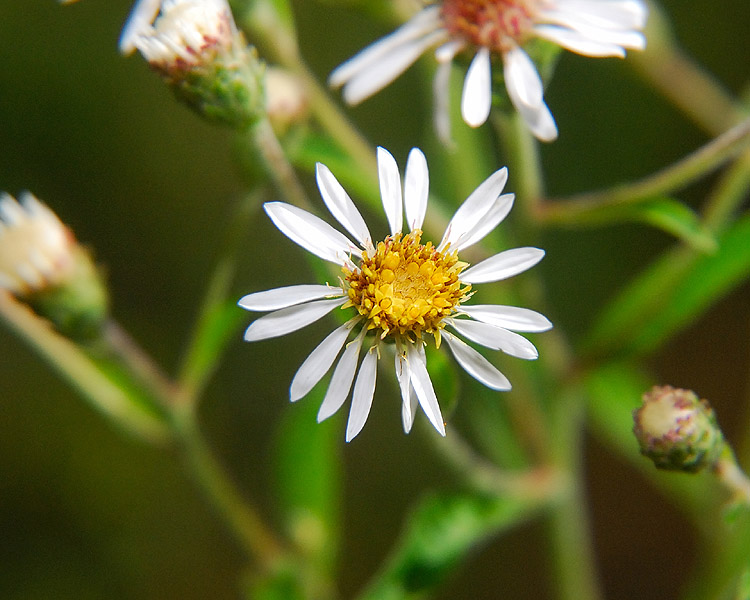
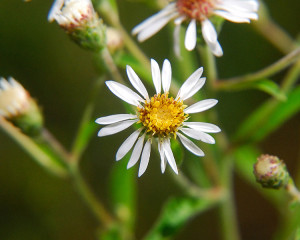
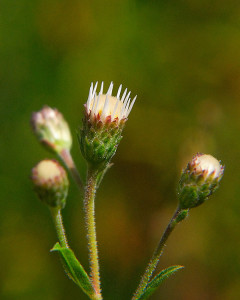
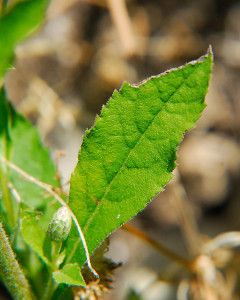
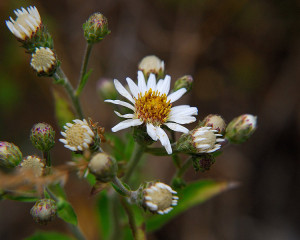
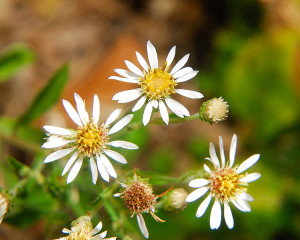
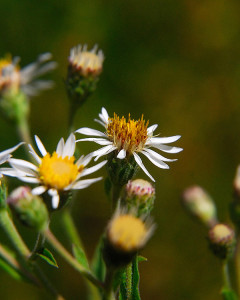








What a pretty flower. It sounds like it could grow almost anywhere that might be difficult for other flowers. I wonder if these are the same thing as Blackfoot Daisies that I’ve seen pictures of since you mention the Blackfoot Indians using them.
Blackfoot daisies are apparently Melampodium leucanthum, so a different genus, but I hadn’t thought about that. They are a similar looking flower though.
You are amazing! We also have a wild flower aster that grows in this region. You are so right about that sphinx moth. I have never seen one setting still, but I googled it and it also called it the hummingbird moth. Those I do see as the sun goes down. Thanks!
You’re welcome Gloria. It was a beautiful moth, and fortunately its markings were so distinctive it made it fairly easy to look up. 🙂
I love wild asters! I don’t think I’d clued into California’s asters, and have been missing the asters of New York and New England.
Silly me.
Unlike a lot of Asters, this one seems to thrive on absolute neglect…must be why it’s growing so well here 😛
Clare, is it supposed to be difficult to tell the native asters apart? I thought I read that somewhere, maybe not. But I have to say, we have some wild asters here, growing on the road at the edge of the wood, that look like a dead ringer for these. Of course, I’m sure they’re not, as “Pacific” pretty much precludes that.
Whenever anything says “deer resistant,” I now take it with a grain of salt. Growing up in the suburbs and then gardening in urban areas, I’d never imagined how destructive they could be. I only saw Bambi and cried when my uncles brought us venison from their kills. Now, I still love them, but I have a bigger picture. 🙂
Once again your knowledge of natives amazes me.
They are annoyingly difficult to tease apart Meredith. Add to that, that the genera for many native Asters are in flux. It’s like a taxonomist’s shell game out there! I think many species will be found to be the same over time, as regionally it seems there are a number of species, made so only on the basis of petal color! But, for now, at least I’m safe calling it a Pacific Aster. It’s genus however, is subject to change without warning 😛
Interesting that they come in colors other than white.
I photographed some Flat Topped White Asters this weekend. Seems early, but nearly everything this year is way ahead.
I agree with you, it could be a great filler! very pretty flowers, and I should say that your photography is great!
Thank you for the compliment Tatyana. One of the suggestions I read was to scatter these Asters in amidst our native yarrow, and I think that might prove to be a lovely combination. One certainly worth trying (especially as the deer don’t seem to eat our yarrow).
Nice post! This aster is also found here in Santa Barbara county, but not in my area. I am in chaparral, uphill from coastal scrub on south facing slopes. Mixed evergreen forest grows at my altitude but on the north facing slopes. So I just miss it.
That’s unfortunate, although you might still just about be able to grow it if you’re that close. Here I only find it on our southwestern facing slopes. It seems to thrive in thin soil, with no irrigation here, but perhaps if you planted some, a little water might help as you’re further south than me.
Cyme is a new word for me – interesting to put a name to an arrangement of flower heads I have seen before but not realised was formalised in name.
Isn’t it a fun word? I’d heard it before, but never really took the time to look up its definition. It’s used a lot in formalized descriptions of the wild Aster species here. I hoped that term might be helpful to someone else. 🙂
Clare it looks like it will be a very pretty addition to the orchard especially if it encourages sphinx moths as I think they are very pretty little insects.
Mmm. I wonder how bad it gets. I’ve been thinking about putting in a few for next summer, in the totally dry areas. But along with the Goldenrod (probably yes) and the Primrose (probably no) I’m on the fence.
Great post!
I think so long as it’s not irrigated, you’d be safe to try it. I can’t imagine it would spread more than Goldenrod providing it’s kept dry, and not fertilized.
What a wonderful daisy-chain making material! You can hang it from your thyrsiflorus! (giggle)
LOL, I don’t have a thrysiflorus, I’d have to make one 😛 I used to love making daisy-chains with English daisies as a child (my parents loved it too, because I’d pick out the daisies in the lawn…they were worse than the dandelions). These do look like a good substitute flower though.
Clare, your post is beautiful…lovely little flowers! So many people consider these just weeds but I really enjoy them and leave them where they grow. They’re so hardy and cheerful! Your photos are wonderful!!
See, we have so many weeds here, I’ve been on a re-classification mission. Providing you’re native, and not invasive, you’re a wildflower. I’ve found a lot of wildflower species here this year…and have so much less weeding to do as a result! 😀
I am very fond of asters, which are a real sign of fall here; and this is a particularly charming species.
BTW, don’t you love the way that nurseries refer to plants as “deer-resistant” rather than “deer-proof”? Gives them plenty of wiggle room when the deer eat them anyway. I guess your asters just didn’t try hard enough to resist those deer!
We have a wildflower that looks very similar. Asters must do well all over the country. I have planted a variety of asters on a hillside that I wanted to become covered with wildflowers and other easy care perennials, and the asters are taking over!
Such a pretty & dainty bloom! Lovel pictures. 🙂
Give those dear, deer the memo! The aster does look similiar to the blackfooted daisy. The aster is a pretty little bloom.
I love asters of all kinds. What an amazing little flower that can thrive in both dry and wet climates 🙂
At first glance those flowers look like a larger version of chamomile, but then the buds look like thistle flowers.
Deer will eat most anything when hungry. They’ve been browsing on our potato foliage! I had to spray some hot pepper mix on what’s left of the potato vines.